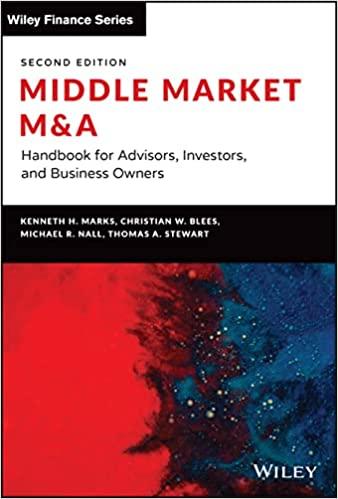Question
AFC Ltd Sales growth 10% Current assets/Sales 15% Current liabilities/Sales 8% Net fixed assets/Sales 77% Costs of goods sold/Sales 70% Depreciation rate 10% Interest rate
| AFC Ltd | ||||||
| Sales growth | 10% | |||||
| Current assets/Sales | 15% | |||||
| Current liabilities/Sales | 8% | |||||
| Net fixed assets/Sales | 77% | |||||
| Costs of goods sold/Sales | 70% | |||||
| Depreciation rate | 10% | |||||
| Interest rate on debt | 5% | |||||
| Interest paid on cash and marketable securities | 4% | |||||
| Tax rate | 30% | |||||
| Dividend payout ratio | 40% | |||||
| Year | 0 | 1 | 2 | 3 | 4 | 5 |
| Income statement | ||||||
| Sales | 1000 | 1100 | 1210 | 1331 | 1464 | 1611 |
| Costs of goods sold | -700 | -770 | -847 | -932 | -1025 | -1127 |
| EBITDA | 300 | 330 | 363 | 399 | 439 | 483 |
| Interest payments on debt | -16 | -16 | -16 | -16 | -16 | -16 |
| Interest earned on cash and marketable securities | 3 | 3 | 3 | 3 | 3 | 3 |
| Depreciation | -100 | -107 | -125 | -146 | -170 | -198 |
| Profit before tax | 187 | 210 | 225 | 240 | 256 | 273 |
| Taxes | -56 | -63 | -68 | -72 | -77 | -82 |
| Profit after tax | 131 | 147 | 158 | 168 | 179 | 191 |
| Dividends | -52 | -59 | -63 | -67 | -72 | -76 |
| Retained earnings | 79 | 88 | 95 | 101 | 108 | 114 |
| Balance sheet | ||||||
| Cash and marketable securities | 80 | 84 | 86 | 86 | 82 | 73 |
| Current assets | 150 | 165 | 182 | 200 | 220 | 242 |
| Fixed assets | ||||||
| At cost | 1070 | 1254 | 1464 | 1704 | 1977 | 2287 |
| Depreciation | -300 | -407 | -532 | -679 | -849 | -1047 |
| Net fixed assets | 770 | 847 | 932 | 1025 | 1127 | 1240 |
| Total assets | 1000 | 1096 | 1200 | 1310 | 1429 | 1555 |
| Current liabilities | 80 | 88 | 97 | 106 | 117 | 129 |
| Debt | 320 | 320 | 320 | 320 | 320 | 320 |
| Stock | 450 | 450 | 450 | 450 | 450 | 450 |
| Accumulated retained earnings | 150 | 238 | 333 | 434 | 541 | 656 |
| Total liabilities and equity | 1000 | 1096 | 1200 | 1310 | 1429 | 1555 |
| Year | 0 | 1 | 2 | 3 | 4 | 5 |
| Free cash flow calculation | ||||||
| Profit after tax | 147 | 158 | 168 | 179 | 191 | |
| Add back depreciation | 107 | 125 | 146 | 170 | 198 | |
| Subtract increase in current assets | -15 | -17 | -18 | -20 | -22 | |
| Add back increase in current liabilities | 8 | 9 | 10 | 11 | 12 | |
| Subtract increase in fixed assets at cost | -184 | -210 | -240 | -273 | -310 | |
| Add back after-tax interest on debt | 11 | 11 | 11 | 11 | 11 | |
| Subtract after-tax interest on cash and mkt. securities | -2 | -2 | -2 | -2 | -2 | |
| Free cash flow | 72 | 74 | 75 | 76 | 77 | |
| Valuing the firm | ||||||
| Weighted average cost of capital | 12% | |||||
| Long-term free cash flow growth rate | 5% | |||||
| Number of Shares | 1000 | |||||
Q1.
Using the information supplied calculate:
- Enterprise Value
- Equity Value
- Price per share
If the current share price is $0.55 per share what recommendation would you make to an investor who was interested in purchasing this stock?
Q2.
Given the following information about potential values for the long term growth rate:
| Long Term Growth Possibilities | Rate | Probability |
| Best | 5% | 0.2 |
| Likley | 3.50% | 0.5 |
| Worst | 2% | 0.3 |
Revise your estimate of the price per share.
How would you explain the difference in the price estimates to an investor?
Q3.
The P/E multiples for three comparable companies are given below:
| Comparables | A | B | C |
| P/E | 7.14 | 5.73 | 7.91 |
Use these multiples and the information from question one to estimate the share price.
Explain the differences in the estimates of share price that you have made in this section?
Could you please help me with this problem? Thank you
Step by Step Solution
There are 3 Steps involved in it
Step: 1

Get Instant Access to Expert-Tailored Solutions
See step-by-step solutions with expert insights and AI powered tools for academic success
Step: 2

Step: 3

Ace Your Homework with AI
Get the answers you need in no time with our AI-driven, step-by-step assistance
Get Started


